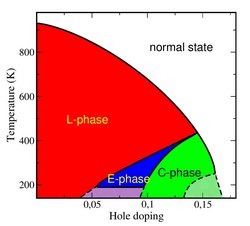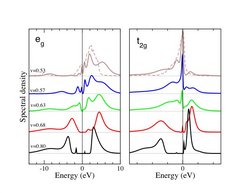Exciton condensation

Materials formed from atoms with singlet (LS, low spin) ground state followed by low-lying (HS, high spin) excitations tend to relax the high degeneracy by formation of long-range order. The nature of the ordered state depends on the inter-atomic interactions: HS-HS repulsion favors ![]() classical spin-state order, while HS-LS exchange favors formation of
classical spin-state order, while HS-LS exchange favors formation of ![]() spinful superfluid (exciton condensate), which can be viewed as Bose-Einstein condesation of HS (bosonic) excitons above LS vacuum. A spinful condensate can exist in several
spinful superfluid (exciton condensate), which can be viewed as Bose-Einstein condesation of HS (bosonic) excitons above LS vacuum. A spinful condensate can exist in several ![]() distinct thermodynamic phases with strikingly different physical properties. Recently, we have demonstrated the formation of
distinct thermodynamic phases with strikingly different physical properties. Recently, we have demonstrated the formation of ![]() spontaneous spin textures in two-band Hubbard model under suitable conditions.
spontaneous spin textures in two-band Hubbard model under suitable conditions.
Spin-state transition

Spin-state transition can be described as abrupt change of magnitude or complete disappearance of local magnetic moment. It can take place both in paramagnetic or magnetically ordered state. While its origin is essentially atomic - competition between crystal field and Hund's coupling - it has interesting consequences for periodic systems such as metal-insulator transition, volume collapse or various ordering instabilities are subject of our interest. We have used LDA+DMFT appraoch to study pressure-driven spin-state transitions in ![]() MnO and
MnO and ![]() Fe2O
Fe2O![]() 3, or
3, or ![]() temperature and
temperature and ![]() doping driven spin-state transition in LaCoO3.
doping driven spin-state transition in LaCoO3.

